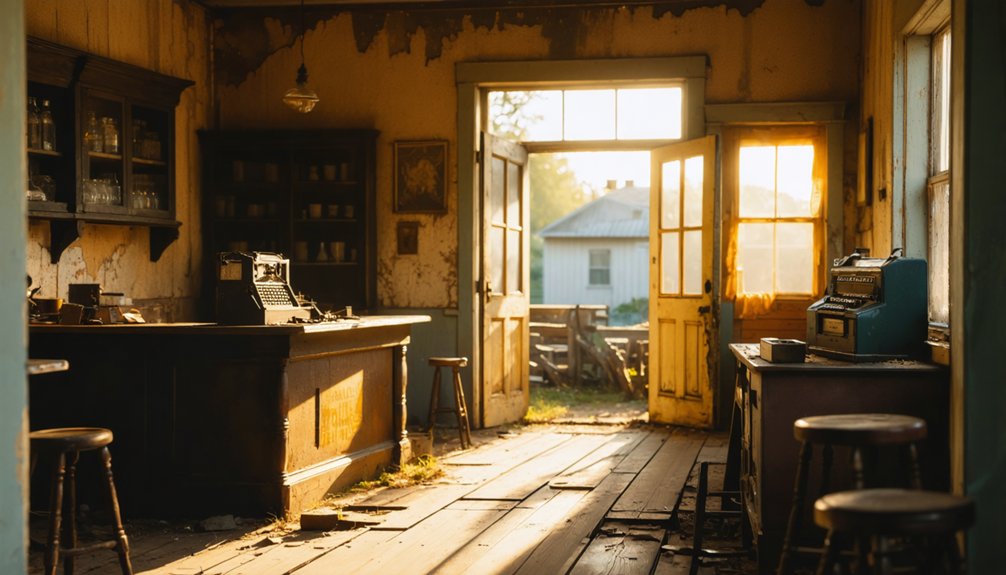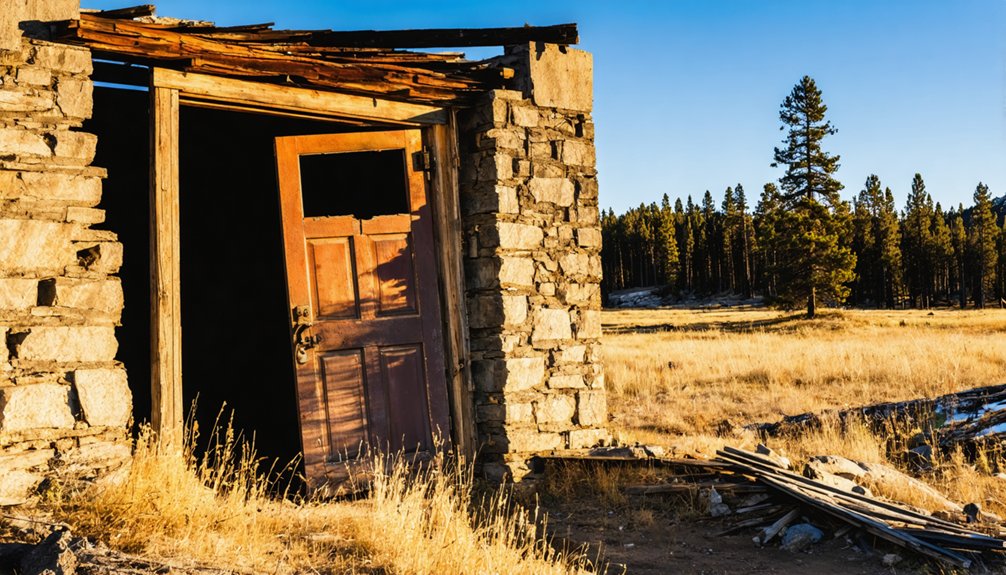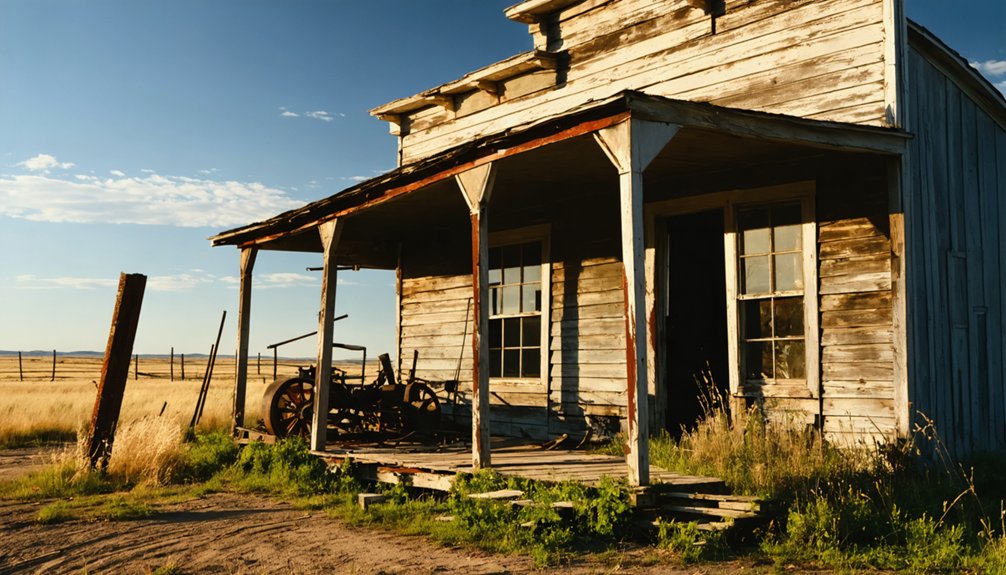You’ll find Terraville’s dramatic story in South Dakota’s Black Hills, where it emerged as a bustling gold mining town during the 1870s rush. At its peak, over 2,000 residents called this mountainside community home, traversing 280-step staircases and mile-long tunnels in their daily lives. By 1982, the expanding Homestake Mining Company operations transformed the once-thriving town of 700 into a 1,000-foot mining pit, though its pioneering legacy in ore processing lives on.
Key Takeaways
- Terraville was a thriving Black Hills gold mining town that emerged during the Gold Rush around the Golden Terra mine.
- The mountainside community reached 2,000 residents at its peak and utilized a mile-long tunnel for transportation and ore movement.
- Residents navigated daily life using 280-step staircases and underground tunnels, forming a close-knit community of 700 people.
- In 1982, the town was demolished and 723 residents relocated to make way for Homestake Mining Company’s open-cut mining operations.
- The town’s location transformed into a 1,000-foot mining pit, though its legacy in ore processing technology and mining innovation endures.
The Birth of a Mining Boomtown
While the Black Hills Gold Rush initially focused on placer mining, Terraville emerged as a strategic settlement centered around the Golden Terra mine, one of the area’s earliest lode operations.
The town’s positioning high on a mountain between Lead and Central City reflected the evolving mining technology of the era, as operations shifted from surface mining to more sophisticated underground extraction. By the end of the century, only two mills remained operational in the area.
At its peak, Terraville supported a thriving community with over 2,000 residents as the mining operations expanded.
Life on the Mountainside
As residents navigated their daily lives in Terraville, the town’s unique mountainside location presented both stunning vistas and significant challenges. Your mountain lifestyle would’ve required exceptional community resilience, adapting to steep terrain where flat ground was scarce. The town’s prime location near Homestake mine workings made it an important hub for mining operations.
You’d find yourself ascending the famous 280-step staircase or traversing the mile-long tunnel to reach neighboring towns for supplies. Similar to Galena Road walkers, residents made daily treks to get necessities and visit other communities.
- Winters brought heavy snow, forcing you to master the art of mountain living through careful food storage and heating adaptations.
- You’d share the mountainside with stamp mills, where the constant rhythm of ore processing became your daily soundtrack.
- Daily commutes meant choosing between footpaths, stairs, or the tunnel – your lifelines to Lead and Central City.
The compact settlement pattern created a close-knit community where over 700 residents turned challenging terrain into their vertical home.
Underground Connections and Daily Transit
Because Terraville’s mountainous terrain posed significant transportation challenges, an innovative network of underground tunnels became the lifeline of both industry and daily life.
You’d find a mile-long tunnel connecting Terraville to Lead, serving both as an ore transport route and a practical pedestrian shortcut. This dual-purpose system enhanced community connectivity while supporting the region’s essential mining operations. Similar to the Keets mining conflict, guards strictly controlled underground access to prevent unauthorized mining and protect company interests. Like USD’s tunnels that were built for power and steam lines, these passages served critical infrastructure needs.
To maintain tunnel safety, armed guards monitored access points, protecting valuable ore shipments and regulating foot traffic. You’d need special passes to navigate certain sections, as companies fiercely defended their underground transit rights.
Despite these controls, the tunnels proved indispensable to residents, who could avoid steep outdoor routes between towns. This underground network transformed isolated mountain communities into an interconnected mining society.
The Golden Era of Terraville
When the Golden Terra mine began operations in 1880, it established the foundation for what would become Terraville, South Dakota’s third-largest mining settlement in the district.
You’ll find a remarkable story of community resilience as the town grew to over 700 residents, developing essential services like a post office and school while becoming the heart of Black Hills gold mining operations.
- The town’s strategic location on a mountain ridge between Lead and Central City positioned it perfectly for ore processing.
- Advanced milling technology, including the Deadwood Terra No. 2 mill, revolutionized low-grade ore extraction.
- A close-knit community emerged, with most residents working in mining or milling operations.
Life in Terraville centered around industrial innovation and determined settlers who transformed a mining camp into a thriving hub of technological advancement in gold processing. The town’s proximity to the Homestake Mining Co. influenced its development, as the company would go on to produce over 24 million ounces of gold from the region.
Mining Operations and Economic Impact
Through its extensive network of stamp mills and tunnels, Terraville established itself as an essential hub in Black Hills gold mining operations.
You’ll find that prominent facilities like the Caledonia No. 1 and Deadwood Terra No. 2 mills specialized in gold extraction using plate amalgamation technology, processing low-grade ore into profitable yields.
The Terra No. 3 mill also played a vital role in the area’s mineral processing capabilities.
The town’s economic reliance on mining was total, with a nearly mile-long tunnel connecting it to Lead facilitating ore transport and worker movement. Today, the area where Terraville once stood is part of the reclaimed mining land behind the massive Homestake Open Cut.
While housing over 700 residents and maintaining basic infrastructure like a post office and school, Terraville depended heavily on nearby towns for commercial support.
The Golden Terra mine, one of the area’s first lode mines, exemplified the town’s importance before being absorbed by the larger Homestake operation.
Tales From the Mountain Town
You’d have found daily life in Terraville demanded resilience, as residents navigated steep mountain terrain and harsh weather conditions that often complicated basic tasks like grocery shopping and commuting.
The town’s unique infrastructure included a mile-long tunnel to Lead that served as a crucial passageway, allowing miners and townspeople to avoid treacherous surface travel during severe weather.
Like many ghost towns today, Terraville shows the challenging historical patterns of settlement in mining communities.
While you could take the 280-step stairway down to Central City for supplies, many residents preferred using the well-lit, maintained tunnel to Lead, which offered a safer alternative to the exposed mountain paths.
Mountain Life Challenges
While many mining towns faced typical frontier challenges, Terraville’s location high in the mountains between Lead and Central City presented its residents with unique hardships.
Mountain isolation and weather extremes shaped daily life, forcing you to adapt to harsh conditions that could cut off access to neighboring communities.
Living at this elevation, you’d have encountered:
- Dramatic seasonal shifts between scorching summers and snowy winters
- Limited access to basic necessities, requiring travel to nearby towns
- Frequent isolation during severe weather events
The rugged terrain didn’t just test your resilience – it complicated every aspect of daily life.
You’d have needed to plan carefully for supplies, knowing that weather could strand you at any time.
The challenging geography meant that even simple errands required significant effort and strategic timing.
Underground Passageways Between Towns
One remarkable feature of Terraville’s infrastructure was its mile-long underground tunnel connecting directly to Lead, serving both as an essential ore transport route and a convenient pedestrian shortcut.
The tunnel engineering demonstrated impressive foresight, with wide passages reinforced to accommodate ore carts while ensuring safe pedestrian travel.
You’d find these underground networks woven throughout the mining district, including a 280-step staircase linking Terraville to Central City.
These passageways weren’t just about industrial efficiency – they became crucial lifelines for community connectivity. When harsh mountain weather struck, you could still reach neighboring towns for commerce, social visits, and necessary services.
The tunnels were well-maintained and lit, reflecting their significance in daily life. While many of these passages have since been lost to time or buried by open-pit mining, they remain proof of mining town ingenuity.
The Town’s Final Days

You’ll find that Terraville’s final chapter began as the last families reluctantly moved away from their mountain homes, surrendering to the expanding Homestake Mine operations.
The mine’s growth meant certain doom for the remaining structures as demolition crews systematically cleared buildings to make way for open-cut mining activities.
What was once a thriving community of 700 residents transformed into a thousand-foot hole, marking the definitive end of Terraville’s nearly century-long existence.
Last Families Move Away
The final chapter of Terraville’s existence unfolded in 1982 when Homestake Mining Company ordered the relocation of all 723 residents to make way for the “Terraville Test Pit” expansion project.
The community dispersal marked the end of a century-long residential history, as families were forced to abandon their homes and seek new beginnings elsewhere.
- You’d find most residents had already been commuting to Lead for jobs and shopping, signaling Terraville’s declining economic viability.
- The closure of the post office and 102-year-old Methodist Church eliminated the last remnants of civic life.
- The demolition of all structures, many over 100 years old, erased the physical traces of your community’s heritage.
Today, only annual reunions preserve the social bonds among former residents who once called Terraville home.
Mining Operations Take Over
Mining operations dominated Terraville’s landscape during its final years, as industrial demands gradually overtook residential life.
You’d have seen the shift from simple placer mining to extensive lode mining operations, with massive stamp mills processing low-grade ore becoming the town’s defining feature. The sprawling industrial expansion of the Homestake Mining Company transformed Terraville’s character, absorbing local mines like the Golden Terra and centralizing operations.
The town’s infrastructure adapted to serve mining needs, including a mile-long tunnel connecting Terraville to Lead. While townspeople used this as a shortcut, it symbolized the growing industrialization.
You couldn’t ignore how commercial life dwindled as residents increasingly relied on Lead and Central City for services, while mining operations claimed more territory until Terraville’s residential identity finally faded away.
Buildings Face Final Demolition
In the summer of 1982, Terraville’s post office closed its doors for good, signaling the town’s official end after more than a century of existence.
The Homestake Mining Company‘s decision to create an open-cut mine meant every structure would face demolition, including the 102-year-old Methodist Church – the oldest operating church west of the Mississippi.
Community memories and historical significance couldn’t save Terraville’s landmarks from destruction:
- The Methodist Church, despite plans for preservation as a historical landmark, fell to demolition crews
- All residential and commercial buildings, most over 100 years old, were torn down
- The mile-long underground tunnel connecting Terraville to Lead was sealed forever
Today, you’ll find only remnants of old roads where this vibrant mining community once stood, now transformed into a 1,000-foot pit.
Legacy in the Black Hills

Despite its complete physical disappearance by 1982, Terraville’s influence on Black Hills mining history remains significant through its pioneering role in ore processing technology and transportation infrastructure.
You’ll find Terraville’s ghost town legacy embedded in the region’s industrial evolution, where its plate amalgamation mills revolutionized the processing of low-grade gold ore.
The town’s historical significance extends beyond mining – it helped establish crucial transportation networks, including the Black Hills & Fort Pierre Railroad and the innovative mile-long tunnel connecting to Lead.
While the 280-step staircase to Central City no longer exists, these engineering achievements shaped the region’s development.
Terraville’s transformation from a 700-person community to an industrial hub demonstrates how Black Hills settlements adapted when placer mining declined, setting precedents for future mining operations.
Frequently Asked Questions
What Was the Average Wage of a Miner in Terraville?
You’d find mining wages in Terraville varied, but they were enough to cover basic living costs. While the exact economic impact isn’t specified, miners earned more than mill workers did.
Were There Any Major Mining Accidents or Disasters in Terraville?
While there’s no documented evidence of major mining disasters in Terraville itself, you’ll find that mining safety was a serious concern, as nearly 100 miners died throughout the broader Black Hills region.
What Happened to the Cemetery When the Town Was Razed?
You won’t find clear records of the cemetery’s fate. While mining companies typically handled cemetery relocation and grave site preservation during town demolitions, Terraville’s burial ground documentation remains mysteriously absent from historical records.
Did Any Famous People or Notable Figures Live in Terraville?
You won’t find records of any famous residents or notable visitors in Terraville. While over 700 people lived there during its peak, historical documents don’t mention any particularly prominent individuals.
What Indigenous Tribes Inhabited the Area Before Terraville Was Established?
You’ll find the Lakota Sioux dominated the region, with the Cheyenne, Arapaho, and Arikara tribes also maintaining strong connections to these sacred Black Hills before mining disrupted their Native history.
References
- https://westernmininghistory.com/towns/south-dakota/terraville/
- https://www.blackhillsbadlands.com/blog/post/old-west-legends-mines-ghost-towns-route-reimagined/
- https://www.ghosttowns.com/states/sd/terraville.html
- https://en.wikipedia.org/wiki/List_of_ghost_towns_in_South_Dakota
- https://archives.bhsu.edu/repositories/2/archival_objects/6138
- https://explore.digitalsd.org/digital/collection/WPGhosttown/id/7020/
- https://www.sdhspress.com/journal/south-dakota-history-15-4/gold-milling-in-the-black-hills-a-photographic-essay/vol-15-no-4-gold-milling-in-the-black-hills.pdf
- https://www.sdpb.org/rural-life-and-history/2023-08-28/the-boom-and-bust-of-central-city
- https://www.mininghistoryassociation.org/Journal/MHJ-v18-2011-Wolff.pdf
- https://westernmininghistory.com/gallery/538480/historical/mines/



